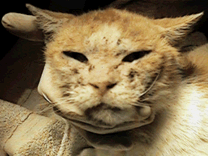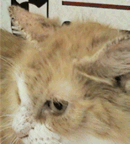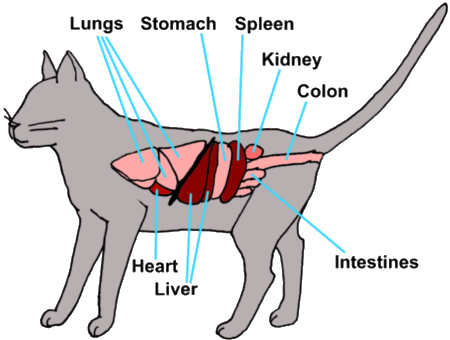Fur Mowing in Cats
What is fur-mowing? In short, the cat is licking off all his hair. Often the belly is nearly as bald as if it were shaved. Sometimes a Mohawk of normal fur makes a stripe down the back, surrounded by bald spots on either side. Sometimes it is the lower back itself that is bald. Often the owner thinks the hair is falling out. Often the veterinarian wonders if the problem is really psychological. The good news is that most cats that mow do not have mental illness.

The answer is almost always much simpler: cats lick off their hair because they itch and it is important not to launch into treatment with psychoactive drugs until causes of itching have been ruled out. For example, in a recent study of 21 cats referred to the University of Guelph Veterinary Teaching Hospital Behavior Service because of excessive hair licking, only two cats were ultimately believed to have a psychological reason for hair licking, and sixteen cats were found to have a true medical basis for itching, and three cats had both.
But let us go back to the beginning: the cat with a big bald spot.
Read Also: Mealtime Enrichment for Cats
How to Groom a Cat: 12 Steps (with Pictures)
How Do we Know the Cat’s Hair is not Simply Falling Out?
A truly observant owner will actually see the cat licking the area, but cats, being private creatures, often do their licking when no one is watching. One might wonder why it is that the itchy dog creates moist, red, oozy, unpleasant-looking hot spots while the itchy cat cleanly licks away only the hair while leaving the skin itself not in the least bit scabbed, red, or even raw.

This turns out again to be the feline nature: refined. Private and refined. In fact, sometimes the mowing cat will have some hot spots as well or a patch of scabs but often there is only a bald area with normal-looking skin exposed.
The truth is simple: there are only a few rare diseases that actually will lead a cat to lose hair in great patches but, if someone still remains skeptical, there is a test called a trichogram that will confirm the answer. A trichogram involves plucking a hair from the affected area. There are most likely at least a couple of hairs in the area but if there are not, hairs from the margin may do as well. Under the microscope, the end of the hair is flat from having been broken off. A hair shedding from the skin will have a tapered, natural end.
Obvious Reasons to Itch
Before embarking on an extensive battery of tests, it is important to rule out obvious causes of itching. The easiest such cause to rule out is a flea infestation. If live fleas or flea dirt are seen in the coat, then the answer is obvious. If fleas are not seen, you cannot assume there are no fleas to be found, particularly if the lower back is one of the balding areas.

Cats are efficient groomers and can lick away all traces of fleas, so we may need to go by the pattern of hair loss, (lower back, possibly including scabbing around the neck). hair loss that changes with the seasons and response to flea control. The first step is virtually always going to be ensuring immaculate flea control. After fleas have been removed from the picture, the cat can be reassessed in a couple of months for hair regrowth and/or with a fresh trichogram. If fleas are not obvious right from the beginning, again, they should not be considered ruled out as a cause, but further investigation will be needed.
The first step is virtually always going to be insuring immaculate flea control. After fleas have been removed from the picture, the cat can be reassessed in a couple of months for hair regrowth and/or with a fresh trichogram. If fleas are not obvious right from the beginning, again, they should not be considered ruled out as a cause but further investigation will be needed.
To properly determine if there are fleas in the household, a flea comb is especially helpful. Flea combs have narrow teeth that can trap live fleas and flea dirt. The cat who is mowing may not have evidence of fleas, but if there are fleas on one of the other pets in the house, you can bet the mowing cat has them too.
Figuring out the Not-So-Obvious Causes
A step-by-step process is important in ruling out hidden allergies, parasites, and even ringworm.
First, the non-invasive tests are performed:
- Several skin scrapes (ideally, if the cat has Demodex mites, they will be found in skin scrapes, though sometimes this is not the case. Notoedres or Cheyletiella mites generally produce more obvious skin damage.)

- A fecal flotation test for parasites (occasionally intestinal worms will create itching in the skin. Also, Demodex mites sometimes show up in the fecal test rather than the skin scrape because the cat has been so efficient at licking them up.)
- Checking the ears with an otoscope (even if the itchy areas are distant from the ears, sometimes ear mites travel out of their normal homes in the ear canal).
- Inspection of the cat with a Wood’s light (a fluorescent light – hairs infected with ringworm fungus often glow in the dark) plus a test for ringworm. The culture will require approximately ten days to grow.
If these non-invasive procedures have not yielded the answer, then there are some choices to make in the approach. Your veterinarian may have a preference as to the order, but the following are several possibilities that might be chosen, each answering different questions.
Skin Biopsy
This can likely be accomplished the same day as the initial visit and yield results as soon as 48 hours later. It is important that the samples be read by a pathologist who specializes in reading skin tissue so your veterinarian may want to request an expert or use a specific laboratory. In this procedure, a local anesthetic is injected into selected areas of skin and an instrument called a punch biopsy (which resembles a tiny cookie cutter) is used to remove small plugs of skin.
The cat will probably have a stitch in each area where a sample was taken.
- The absence of abnormalities in the tissue virtually confirms a psychological (the correct term is psychogenic) cause of the mowing. (In the Guelph study mentioned above, three cats had both psychogenic mowing AND medical disease.)
- Ringworm can be confirmed more quickly than with the culture (the culture sometimes picks up ringworm when the biopsy does not, though, so doing both tests is very reasonable).
- Allergies should be readily identified (though it will not be possible to tell what type of allergy: insect-related, food, or airborne).
Food Allergy Trial
The only way to determine if the cat has a food allergy is to put the cat on a trial diet that the cat could not possibly be allergic to (either a hydrolyzed protein diet or a novel protein diet) for a long period of time and see if the mowing stops. How long? Many cats respond in three to four weeks but some require a good 2 months, so to be sure, a two-month trial is typically recommended.
The advantage of this test is that it can make the correct diagnosis and provide treatment.
- The advantage of this test is that it not only can make the correct diagnosis but also provides treatment.
- There are two important disadvantages of this test. The first is that no results will be available for potentially two months. The second is that many cats are picky about the diet food and it may be hard to find one the patient likes. If the cat goes outside, it will not be possible to do a food trial as it will not be possible to control what the cat eats.
See our related page on food allergies for more details.
Flea Control Trial
As mentioned, immaculate flea control is very important in ruling out fleas as a cause of mowing, and it is crucial not to assume that if fleas are not seen, then they must not be involved. There are numerous sophisticated flea products available, and every veterinarian has a favorite. Your veterinarian will instruct you on a schedule for use in this situation it may be more frequent than the manufacturer’s recommendation). The trial should continue for at least 6-8 weeks, after which the cat can be reassessed for hair regrowth or reduction in licking.
- This trial only answers the question of whether or not the problem is flea-related, and it takes approximately two months to do so.
- To properly determine if there are fleas in the household, a flea comb should be used, ideally on a pet that is not itchy or mowing. Flea combs have narrow teeth that can trap live fleas and flea dirt.
In an effort to save time, the food trial and flea control trial can be done at the same time. If the cat has not responded after two months, another disease/condition can be pursued. If the cat responds after two months, the cat can be challenged with the original diet. If mowing recurs (which generally takes two weeks at the most on the original diet), then the food allergy is the answer. If the cat continues not mowing after the original food is introduced, then the problem is flea-related.
Demodectic Mange Dipping Trial
Demodectic mange mites can be difficult to find in cats, especially if the cat is over-grooming. It is important to realize that a negative skin scrape does not mean that the cat doesn’t have mites. Fortunately, there is another way to determine if the cat has Demodex mites; the cat can be treated for mites to see if the mowing stops. The cat is treated with lime dip weekly for three weeks. If there is improvement in hair regrowth or a reduction in self-licking, then three more weekly dips are done for a total of six dips, and any other cats in the house are also treated with a total of six dips. Lime sulfur dip is not pleasant. It stains fabric and jewelry and smells like rotten eggs. For these reasons, many cat owners opt for dipping to be done in the hospital rather than at home.
Demodex mange mites are more common in certain geographical areas (such as the Southern U.S.) than others. At which point a dipping trial should be done depends in part on the likelihood of demodicosis being the problem. If Demodex mites are not found on a skin scraping, and they frequently are not even if they are in the skin, then the response to dipping becomes the only way to determine if the cat has them.
Lime sulfur dips are very drying to the skin, and special conditioners may be needed after the third dip if dipping is to continue.
Steroid Trial
For this trial, the patient receives some kind of cortisone-type treatment for three to four weeks. At the end of that time one can tell if the mowing has improved (and the mowing is said to be steroid responsive) it hasn’t improved at all (and the mowing is said to be steroid non-responsive.) Knowing whether or not the mowing is steroid-responsive helps classify possible causes. For example, seasonal steroid-responsive mowing is most likely to be from fleas (technically, allergy to the flea bite) or an airborne allergy. Non-seasonal steroid-responsive mowing is most likely going to be from a food allergy or from demodicosis. Steroid non-responsive mowing is most likely to be from a parasitic or fungal problem or a food allergy.
Many experts like to do the steroid trial at the beginning of the workup while others wait until more results are in.
- The use of steroids can make ringworm worse so many experts prefer to hold off steroids until the ringworm culture is finished.
- The use of steroids will interfere with a skin biopsy. If a biopsy is being considered, it should be done prior to steroid use.
- The use of steroids will interfere with food trials or flea control trials.
- The steroid trial is inexpensive and one of the least labor-intensive tests that can be done.
What if the Cat Really has Mental Illness?
This is generally called psychogenic mowing. We don’t imply that we know if cats are licking out of obsession, anxiety, or even boredom. We simply say that there is nothing wrong with the skin. The approach is aimed at environmental enrichment. This means the cat gets more toys, more games (feeding in a different location daily to create a hide-and-seek sort of cat entertainment), and more attention. See more information on environmental enrichment for cats.
As for anxiety, there are several approaches. Feliway® products employ a pheromone that is naturally made by cats to communicate that a territory is safe and secure. This pheromone is available in a room spray or a plug-in defuser. Alpha-casozepine is a cow’s milk protein with mood-stabilizing properties. It can be given as an oral supplement (Zylkene®) or in a commercial diet (talk to your veterinarian). There are also medications for anxiety: clomipramine, fluoxetine, and even amitriptyline. These can be used to relieve a cat’s need for compulsive over-grooming after more conventional causes of itchy skin have been ruled out.
Overall, fur mowing can be a frustrating condition for which no cause is obvious, and the only solution is to try different treatments and see what happens. Hopefully, this article has provided some meaningful suggestions for testing and treatment approaches.


































